Below is a list of all the UROS 2023 projects, each with a summary of each, and a link to their showcase poster.
Aesthetics and Electrical Characteristics of Guitar Pickups

Student Researcher Name: William Marriott
Academic Supervisor Name(s): Dr Nick Tucker, Dr Nikola Chalashkanov
In this research project, the aim is to investigate the relationship between the physical characteristics of guitar pickups and the effect that it has on the frequency responses. Additionally, the effects of manufacturing errors and identification of defects. Methodology involves measuring data from samples of pickups with specifically manufactured parameters by subjecting the pickup to varying ac voltage frequencies and measuring the corresponding ac current. From the literature review it is evident there should be a clear relationship between parameters and pickup responses yet only small sample sizes are used and coverage for variety of parameters is not extensive. Only a few references mention manufacturing errors and defect identification within the pickup. The results obtained provide useful information for detection of manufacturing errors and their effects on the pickup system, since there is a strong correlation between the various characteristics and frequency response measured.
Can condensed matter physics inform the philosophy of substance?
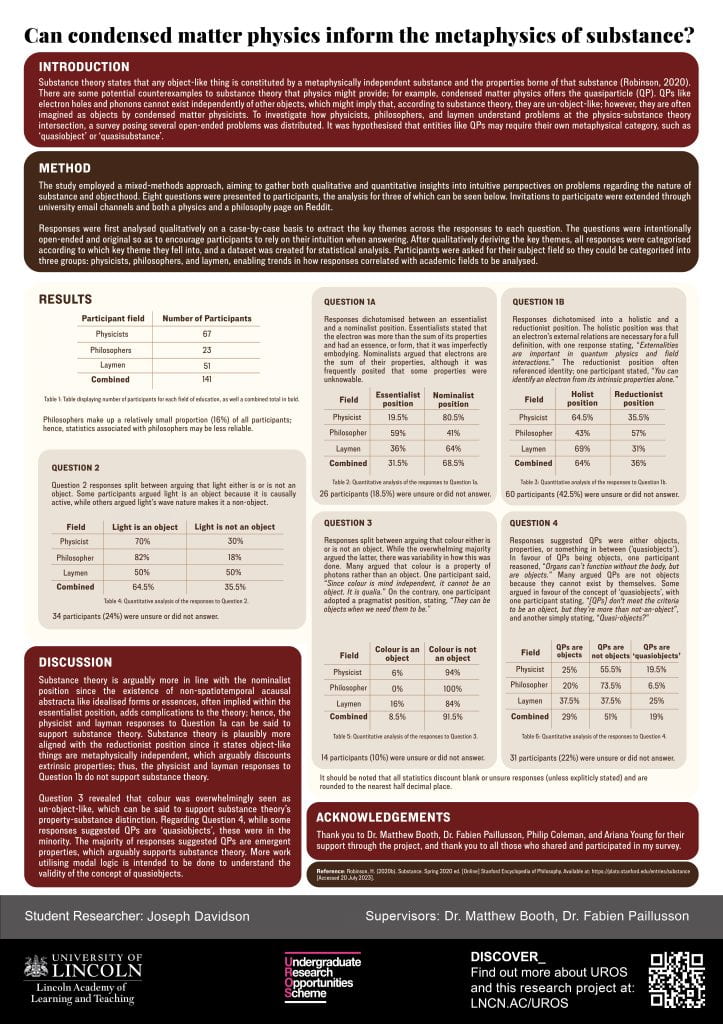
Student Researcher Name: Joseph Davidson
Academic Supervisor Name(s): Matthew Booth, Fabien Paillusson
The project was split into two parts. One was in the creation and distribution of a survey that posed a series of relevant philosophical problems to participants (who were mostly physics and philosophy academics), and then the subsequent qualitative and quantitative analysis of the results of said survey. The second part of the project involved a great deal of research into how quasiparticles, an entity from the field of condensed matter physics, might fit into substance theory. This second part is a topic I intend to expound upon further and more formally in my dissertation.
Overall, I found the UROS project to be an intellectually enriching experience! It was a great opportunity to get a taste of what working in academia might be like in the future; I developed a lot of skills I think I would have missed out on had I not done the project. I am extremely grateful for the opportunity, and I hope to do more work like this in the future.
Compliant soft linear mechanism for use in soft robotic applications
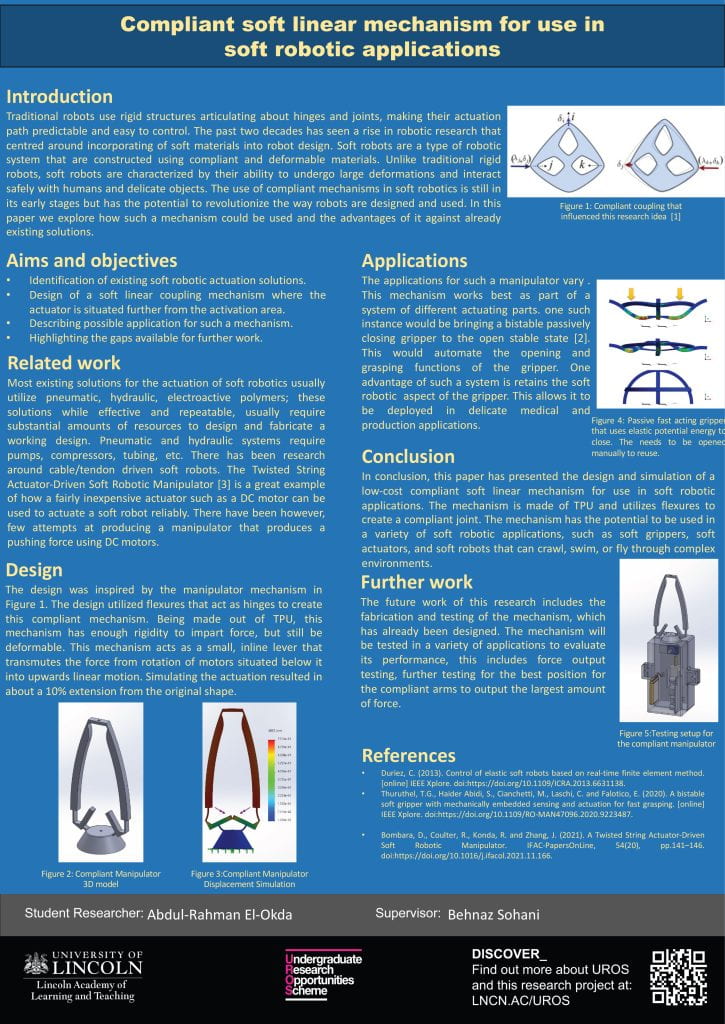
Student Researcher Name: Abdul-Rahman El-Okda
Academic Supervisor Name(s): Behnaz Sohani
The project presented here was funded by the University of Lincoln’s UROS scheme, providing undergraduate students with the opportunity to work alongside academics on research projects to help develop their scholarly and employability skills. This paper presents the design and simulation of a compliant soft linear mechanism for use in soft robotic applications. The mechanism is made of TPU and utilizes flexures to create a compliant joint. The compliant soft linear mechanism has several advantages over traditional rigid and soft robot actuators. The soft materials used make it safer to interact with humans than rigid robots, while also having the advantage of being simpler to design and fabricate than more traditional soft robotics designs that use pneumatic or hydraulics, which can reduce the cost of soft robots.
Illustration of Two-Fold Origami Axioms
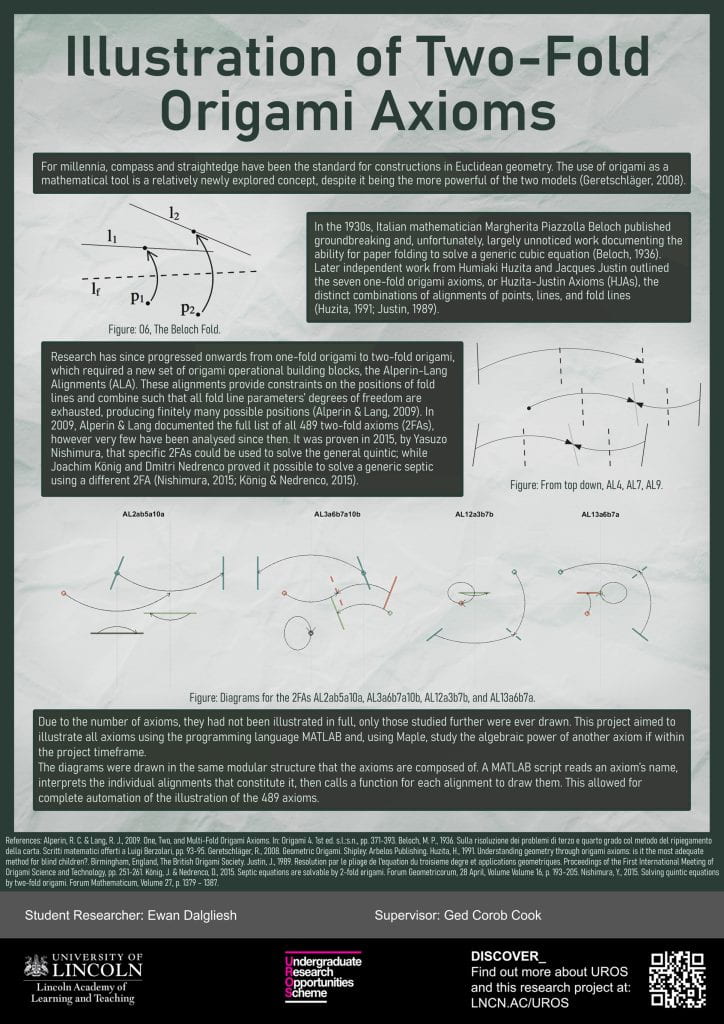
Student Researcher Name: Ewan Dalgliesh
Academic Supervisor Name(s): Dr Ged Corob Cook
For millennia, compass and straightedge have been the standard for constructions in Euclidean geometry. The use of origami as a mathematical tool is a relatively newly explored concept, despite it being a stronger model than the former (Geretschläger, 2008). In the 1930s, Beloch proved that paper folding can solve a generic cubic equation (Beloch, 1936), disproving Row’s claim that the cube root of two cannot be constructed using paper folding (Row, 1893). After reaching the limit of single-fold origami, research moved to studying two-fold origami, in which the Alperin-Lang alignments (AL1-AL10) form the building blocks of origami axioms. A two-fold origami axiom (2FA) is a minimal set of two-fold alignments that fully define two simultaneous fold lines on the Euclidean plane, admitting finitely many solutions (Alperin & Lang, 2009). Out of a possible 93,636 possible axioms, Alperin & Lang discovered there are 489 distinct axioms that fully define two simultaneous fold lines. This project aimed to illustrate all 489 axioms utilising computer automation and it is hoped this accessibility will encourage future research into the field.
Investigating the Oral Histories of the Barbican on St. Mary’s Street, Lincoln

Student Researcher Name: Olivia Hennessy
Academic Supervisor Name(s): James Greenhalgh
The history of the Barbican building (formerly known as the Albion hotel) on St Mary’s Street, opposite Lincoln’s railway station, transitions into a community asset. The Lincolnshire co-op and the University of Lincoln are now working in partnership on the building, which will be transformed into the Barbican creative hub to launch in spring 2024. The project seeks to explore and uncover the voices of individuals who might not appear in more conventional histories, whilst tracking the relationship between ordinary lives and the built environment. Specifically, oral history techniques have been utilised to understand the importance of the building in the post-war period. Interestingly, the research revealed the Barbican fostered a sense of belonging and social change, which became an important element of nostalgia within the community. The appraisal further concludes the Barbican situates Lincoln into the larger cultural and historical contexts.
Investigating the relationship between mood instability and ADHD traits and creativity with ECG response during a colouring activity
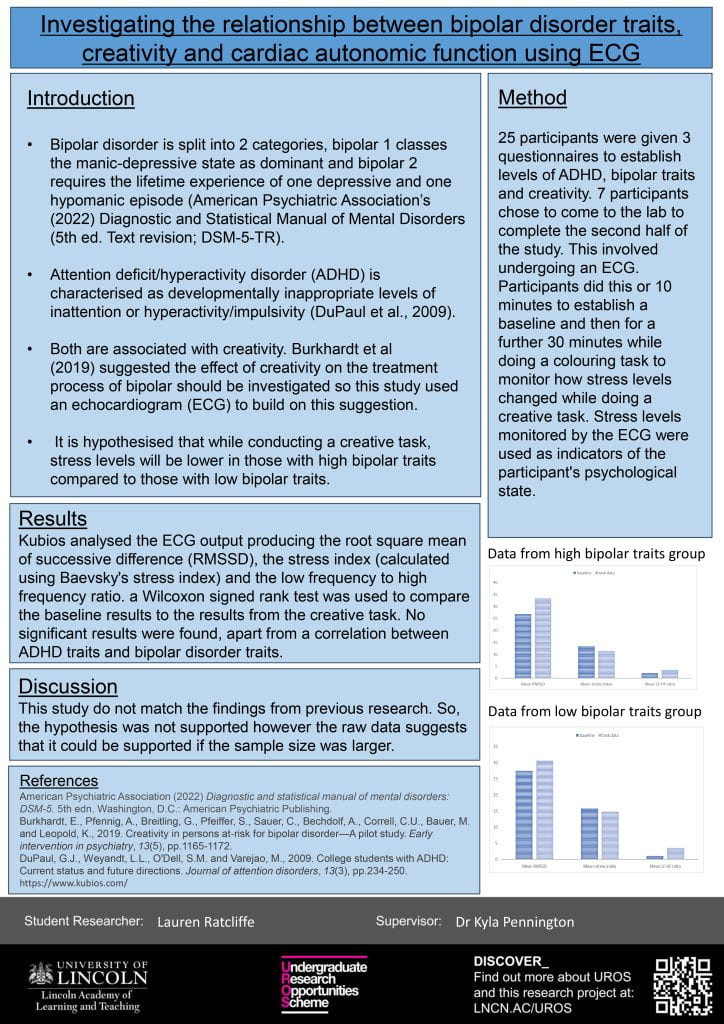
Student Researcher Name: Lauren Ratcliffe
Academic Supervisor Name(s): Dr Kyla Pennington
Despite evidence indicating creativity can benefit a wide range of mental disorders, this hasn’t been applied to bipolar disorder, so this study aimed to rectify this. Using an electrocardiogram (ECG), heart rate variability (HRV) was measured to indicate a person’s physiological state in relation to stress and assess whether creative tasks may help reduce stress and its effect in individuals high in bipolar disorder traits. Three questionnaires were administered assessing levels of bipolar, creativity and ADHD traits. Participants then participated in an ECG. Participants did a 10-minute baseline and then 30 minutes of colouring while monitoring their heart rate. A correlation between bipolar traits and ADHD traits was found. No other significant results were found but the data indicates a decrease in stress when doing the colouring task in high and low bipolar trait groups. Therefore, the hypothesis was not supported, despite the raw data, so further research is needed.
Is the periodic impact flux on Earth sensitive to whether the Milky Way is a grand design or Flocculent spiral galaxy?
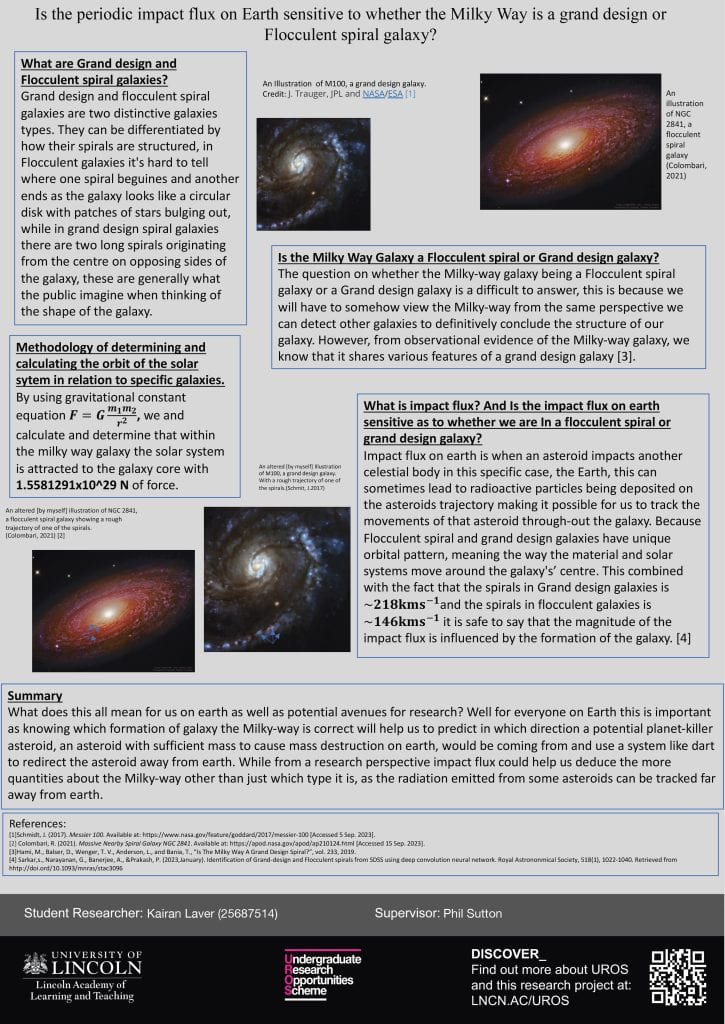
Student Researcher Name: Kairan Laver
Academic Supervisor Name(s): Phil Sutton
Impact Flux in this context simply refers to asteroids impacting celestial bodies. This paper looks at if the impact flux on Planet Earth and whether it is sensitive to the Milky-way galaxy being either a Grand Design spiral galaxy or a Flocculent Spiral Galaxy. This research is important in astrophysics as meteorite and asteroids can have a radioactive signature which can be tracked back through the asteroids trajectory, this can be useful in determining the structure of the Milky-way galaxy, as currently we some observational evidence of the milky-way suggesting it could be a Grand-design galaxy, however we are still unable to verify those observations, as we cannot currently confirm using the same process as we go through to look at other galaxies. This paper suggests that there is a potential link between the impact flux and Earth being sensitive to the structure of the Milky way, however more research is required to say for certain.
Mixed method data collection on a hard-to-reach population: using questionnaires and interviews to understand disabled students experience with careers development activities
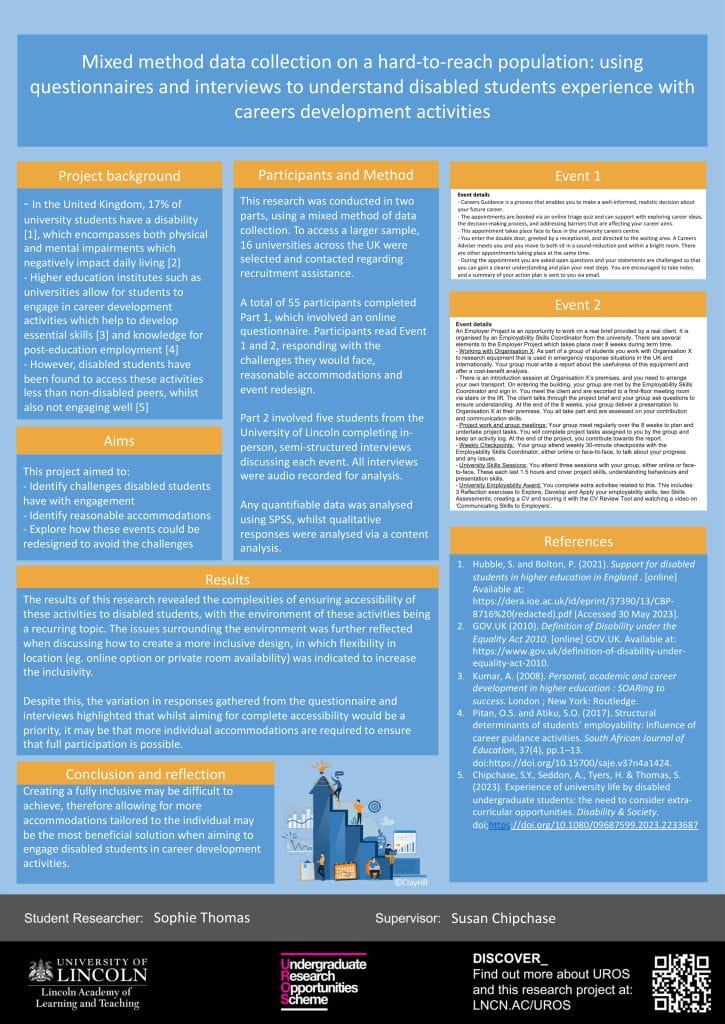
Student Researcher Name: Sophie Thomas
Academic Supervisor Name(s): Susan Chipchase
This projected was funded by the University of Lincoln’s UROS scheme, which allows for students to gain essential research skills whilst working in collaboration with academics on a project of their choice. In the United Kingdom, approximately 17% of students are reported to have a disability. Whilst career development activities have been proven to be beneficial for post-graduate employment, it has been suggested that disabled students do not engage well with these. This research aimed to understand the challenges that disabled students would face with two key career development activities, and whether disabled student engagement could be enhanced through reasonable accommodations or event redesign. The results of this research highlighted the complexities of ensuring accessible opportunities for disabled students and are discussed in summary due to the potential for publication. Throughout this experience, I have gained vital research skills and had the opportunity to implement new data collection techniques that I would not have had otherwise, whilst also furthering my passion for conducting research.
Non-standard Quantum-like Models of Human Cognition
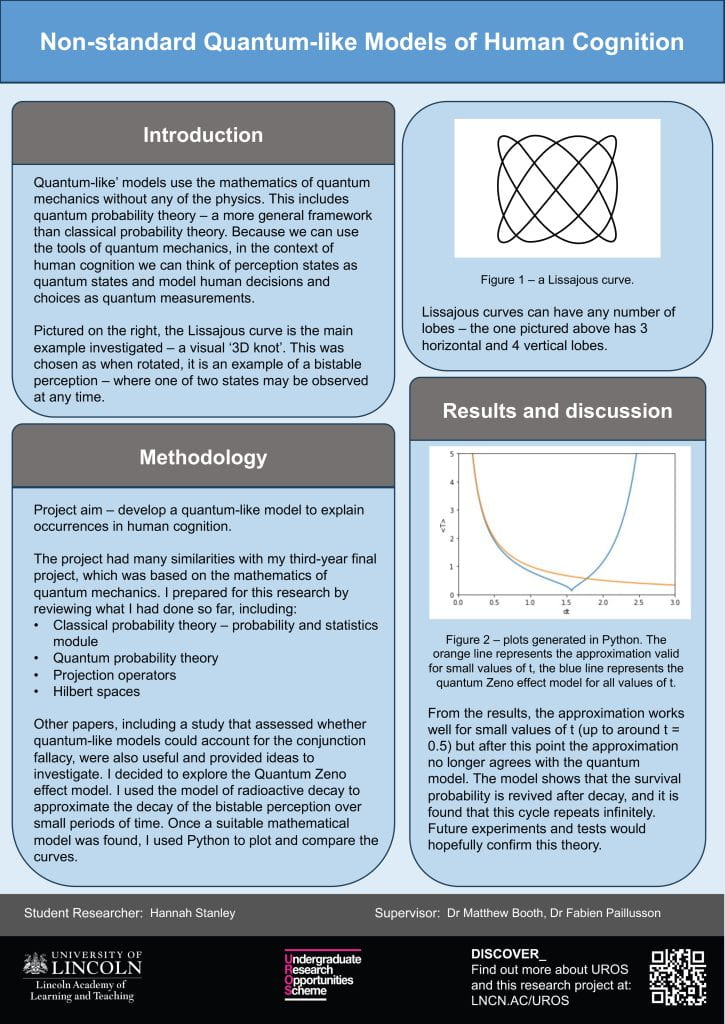
Student Researcher Name: Hannah Stanley
Academic Supervisor Name(s): Dr Matthew Booth, Dr Fabien Paillusson
Human cognition; the mental process of acquiring and understanding information, is still a generally poorly understood subject among scientists and philosophers. The research carried out during this summer project focuses on developing quantum-like models to give a mathematical understanding of how some aspects of human cognition occur. The main focus of the project was investigating a bistable optical illusion, which can be observed to be in one of two states at any time, known as a Lissajous curve. When a person observes the curve rotating, it may be perceived to ‘flip’ and change direction. However, if the rotation is too slow, this may prevent the flip from occurring.
The project studies the Quantum Zeno Effect and how this may be responsible – the idea that a particle that is constantly observed will never decay. The same idea applies in the context of the optical illusion – if enough measurements are made, then perhaps the flip may be prevented.
Optimising Resin and Fumed Silica Infills for Porcelain Conservation

Student Researcher Name: Quinn deMestre
Academic Supervisor Name(s): Lynda Skipper
This project investigates the impact of fumed silica on the long-term properties of two-part epoxy resins, with specific focus on colour stability, chemical structure, and adhesive strength. The research was carried out in two phases. The first phase artificially aged blocks of resin to view long-term colour change. The second phase artificially aged porcelain tiles repaired with the resin before strength testing was completed. I intend to publish the results in a conservation subject journal and cannot disclose results, however visual trends did emerge. Through the project I developed my time management skills and will use these during my final year of studies to improve my project execution. I enjoyed my experience with the Undergraduate Research Opportunities Scheme (UROS) and hope to complete more research projects in the future.
The article explores the methodology used as well as discussing and reflecting on the lessons I learned during the project. It also offers recommendations for other students completing similar research projects.
Replicating the Lydia Lawrence bonnet: an ‘experimental conservation’ approach to collections care and public engagement for the D.H. Lawrence Birthplace Museum

Student Researcher Name: Laurie Rees
Academic Supervisor Name(s): Leah Warriner-Wood
Heritage conservation frequently faces challenges of protecting the material stability of objects in poor conservation condition, particularly in an historic house setting. Often the best way to protect objects is to keep them in specific conditions in storage, but this inhibits the storytelling potential of a museum or historic house. This is true for the D.H Lawrence Birthplace Museum, where a key piece in the house museum’s collection cannot be displayed due to poor conservation condition. The object in question being a sun bonnet made by Lydia Lawrence, D.H. Lawrence’s mother. After seeking out conservation treatment and potential for replication at the University of Lincoln’s Conservation department, Lincoln Conservation took on the project. The University of Lincoln Undergraduate Opportunities Scheme (UROS) provided funding for the author to produce a replica of the bonnet, which allowed for exploration of the role of craft skills and replica making in conservation practise.
Swan Track – A software for monitoring the movements of swans

Student Researcher Name: Raul Lobo
Academic Supervisor Name(s): Jenny Dunn and Laetitia Marechal
The Lincoln Swan Project monitors the movements of Mute Swans (Cygnus olor) in and around Lincoln by data collectors (members of the public) sending in sightings of Lincoln Swans. During my time as a member of the Lincoln Swan Project, one of my roles was to send data collectors a written description of the sighting history of any swan of interest. In October 2022, I contacted my supervisors (Dr Jenny Dunn and Dr Laetitia Marechal) about creating a mapping software which would display the movements of the swans – Swan Track. These maps would allow both researchers and the public to visually see and have a better understanding of where the swans travel to. We built the foundation of the tracking software under the Undergraduate Research Opportunity Scheme (UROS). UROS provided us with a platform to develop a tracking system so we could visually see where Lincoln Swans travel to.
Testing ‘Prometheus’ – An analytical computer program to predict how proteins fold and interact with other compounds
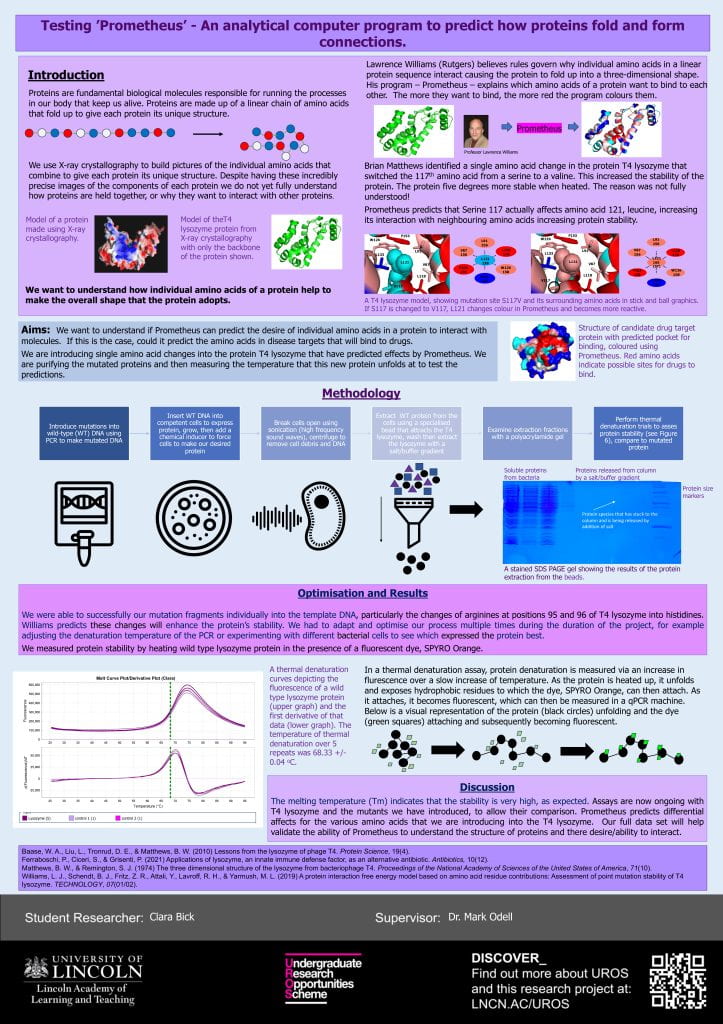
Student Researcher Name: Clara Bick
Academic Supervisor Name(s): Dr. Mark Odell
Over the summer I had the opportunity to complete a research project in a biochemical laboratory thanks to UROS and my university. I expanded my technical skills working with DNA and protein, as my project focused on the enzyme T4 lysozyme and how changing single amino acids in the gene that encodes for it also changes the stability of the overall protein. This was done to assist a larger group of researchers, a collaboration between the University of Lincoln and Rutgers University, USA. We wanted to prove that the analytical computer program ‘Prometheus’, which is said to be able to predict how proteins fold and how likely each amino acid is to accept new interactions with other compounds, is accurate and can aid in the discovery and improvement of new and existing drug molecules.
Virology for Dummies: An introduction to Herpes Simplex Virus 1 and my experience in a Virology Lab
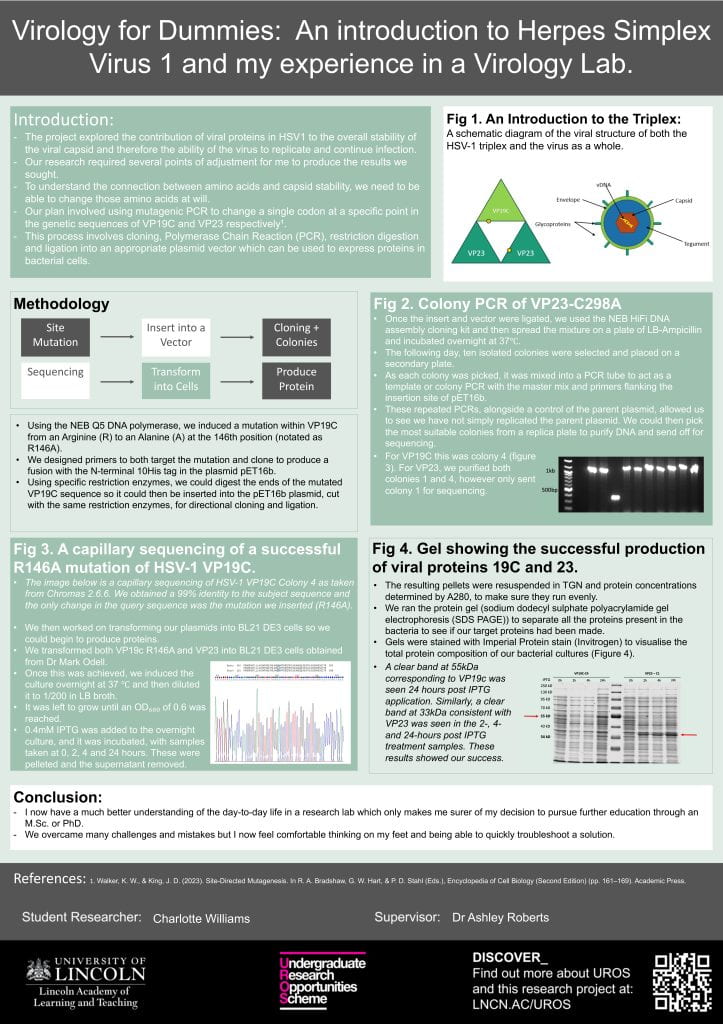
Student Researcher Name: Charlotte Williams
Academic Supervisor Name(s): Dr Ashley Roberts
The project explored the contribution of viral proteins in HSV1 to the overall stability of the viral capsid and therefore the ability of the virus to replicate and continue infection. Our research required several adjustment points for me to produce the results we sought. To understand the connection between amino acids and capsid stability, we need to be able to change those amino acids at will. Our plan involved using mutagenic PCR to change a single codon at a specific point in the genetic sequences of VP19C and VP23 respectively. This project has helped me to realise that postgraduate study is the right path for me. While I originally planned on doing a master’s degree, I’ve been encouraged to pursue a PhD and I feel like I have the confidence to do so now. I have felt incredibly supported in this decision, and I know this experience will prove invaluable in my applications.
